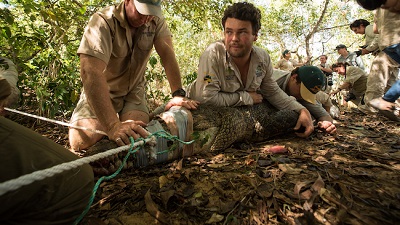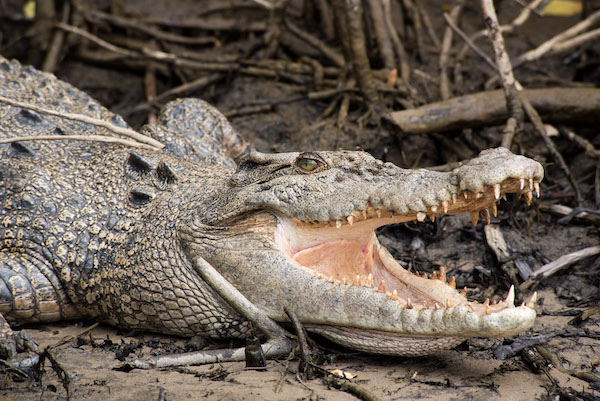
Quantitative biology – the science of using mathematics, statistics and computational techniques to study life and living organisms – has helped University of Queensland researchers discover that saltwater crocodiles to be more tolerant of their neighbours than previously thought.
Long-regarded as the most aggressive and least social crocodile species, research backed by Australia Zoo owner Dr Terri Irwin, has shed light on croc behaviour on a population scale.
Over a decade, a research team, involving UQ researchers, used implanted tracking devices to determine the movements of a wild population of estuarine crocodiles (also known as saltwater crocodiles, or ‘salties’) in the Steve Irwin Wildlife Reserve on Cape York Peninsula.
Working under Professor Craig Franklin (head of UQ’s Franklin Eco-Laboratory and co-lead of the saltie research project alongside Dr Terri Irwin), UQ PhD candidate Cameron Baker ended up with more than five million crocodile detections from the tracking devices.
Cameron turned to UQ’s Research Computing Centre (RCC) for guidance as to how to run his simulation models with such a data set.
RCC staff pointed him towards UQ high-performance computer Tinaroo and an HPC-embedded version of RCC-supplied scientific workflow Nimrod as the best tools for the job.
Tinaroo is a traditional HPC cluster for broad research use across UQ, and Nimrod is a specialised parametric modelling system.
According to Cameron, saving a lot of time was the biggest benefit of using Tinaroo and Nimrod together.
“I had the ability to undertake my random simulations and calculate values from these simulations in only a matter of days, compared to several months using a traditional computer system,” he said.
Previously, running his simulations had been “extremely time-consuming, and as such I was potentially going to have to reduce the number of simulations included within my study. Tinaroo and Nimrod improved the accuracy of my predictions through increased simulation numbers,” said Cameron.
“While the brute force and computing power that is available utilising Tinaroo certainly assisted in getting the run time of my simulations down, the major advantage for my work came from my use of Nimrod embedded within Tinaroo.

“Despite the power of Tinaroo being amazing due to the sheer number of computational cores available, I did initially find it difficult to tap into Tinaroo’s full power due to the challenges of running projects in parallel across multiple nodes. However, Nimrod provided me with an easy-to-use format to do just this, which drastically assisted me with decreasing the running time of the simulations that I was undertaking.
“I used Tinaroo and Nimrod in my project to determine whether individual crocodiles overlapping their territories with their neighbours was due to them actively maintaining these overlaps, or if it was just due to random chance. To do this, I created a model which simulates the movements of each crocodile as if they were moving throughout the river at random.
“Using Tinaroo and Nimrod, I was able to run this random model 100 times for each of the 105 crocodiles within my study. Following this, I also used Tinaroo and Nimrod to calculate the amount of territory overlap present between each pair of crocodiles for each of the simulations I created. In doing so, I was able to demonstrate that crocodiles were actively maintaining their overlap with their neighbours, with some individuals maintaining these connections for up to five years.”
Not having worked with HPCs before, Cameron undertook RCC’s introductory HPC workshop. “I found this training incredibly useful as it gave me a broad overview of the HPC systems available here at UQ. I was also able to get several pointers on how to operate and access Tinaroo and the other HPC services, along with some tips for using Linux, making things easier for me to get started.”
Cameron also accessed the RCC Support Desk and UQ’s weekly Hacky Hour meetup for further help with his Tinaroo and Nimrod usage.
“I received a substantial amount of help from [RCC HPC Manager] Dr David Green, along with other members of the RCC team and the people who attend Hacky Hour,” said Cameron.
“While I was initially struggling on implementing my jobs within a traditional Tinaroo job submission, after a meeting with David to discuss my aims and what I was trying to achieve, we made the decision that it would be best to utilise Nimrod embedded within Tinaroo.
“Following this, David provided me with a tremendous amount of assistance in not only preparing the job for working within Nimrod, but also troubleshooting any errors that occurred during the process. His assistance was extremely valuable for me, as prior to this I had not had experience using HPCs or Linux. Through his assistance and the examples that he provided, I was able to learn enough to become comfortable not only editing but preparing my own jobs using Linux and the HPC system, and for that I’m incredibly grateful.”
Cameron is working on the saltwater crocodile project not only alongside Professor Craig Franklin and Dr Terri Irwin, but also the Franklin Eco-Lab’s Dr Ross Dwyer an expert in spatial and movement ecology that utilises large datasets. The project is learning more about the social behaviour and dynamics of saltwater crocodiles. Where dominant males were once thought to exclude all other crocodiles from their territories, except for a handful of select females, it appears these salties share access to feeding areas and tolerate smaller male and female crocodiles in their territory. The project team looked at how these behaviours are influenced by seasons and a crocodile’s sex.
“Our results revealed that estuarine crocodiles are not as intolerant of their neighbours as we thought, with individuals displaying highly structured relationships with their neighbours regardless of whether they were male or female,” said Cameron.
“I will continue to look into the social relationships between individuals to determine crocodiles’ preferences or aversions of who they interact with, and the factors influencing how individuals associate with each other.”
The research project has been funded by two Australian Research Council Linkage grants, with Australia Zoo and CSIRO as industry partners, and infrastructure support from Rio Tinto Aluminium Limited.
For more information about UQ’s Master of Quantitative Biology program, visit UQ Future Students.



